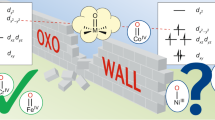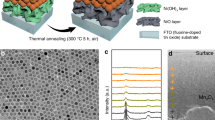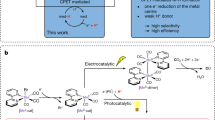Abstract
Redox-inactive metals are found in biological and heterogeneous water oxidation catalysts, but, at present, their roles in catalysis are not well understood. Here, we report a series of high-oxidation-state tetranuclear-dioxido clusters comprising three manganese centres and a redox-inactive metal (M). Crystallographic studies show an unprecedented Mn3M(µ4-O)(µ2-O) core that remains intact on changing M or the manganese oxidation state. Electrochemical studies reveal that the reduction potentials span a window of 700 mV and are dependent on the Lewis acidity of the second metal. With the pKa of the redox-inactive metal–aqua complex as a measure of Lewis acidity, these compounds demonstrate a linear dependence between reduction potential and acidity with a slope of ∼100 mV per pKa unit. The Sr2+ and Ca2+ compounds show similar potentials, an observation that correlates with the behaviour of the oxygen-evolving complex of photosystem II, which is active only if one of these two metals is present.
This is a preview of subscription content, access via your institution
Access options
Subscribe to this journal
Receive 12 print issues and online access
$259.00 per year
only $21.58 per issue
Buy this article
- Purchase on Springer Link
- Instant access to full article PDF
Prices may be subject to local taxes which are calculated during checkout





Similar content being viewed by others
References
Fukuzumi, S. & Ohkubo, K. Metal ion-coupled and decoupled electron transfer. Coord. Chem. Rev. 254, 372–385 (2010).
Fukuzumi, S. in Progress in Inorganic Chemistry Vol. 56 (ed. Karlin, K. A.) 49–154 (Wiley, 2009).
Yachandra, V. K. & Yano, J. Calcium in the oxygen-evolving complex: structural and mechanistic role determined by X-ray spectroscopy. J. Photochem. Photobiol. B 104, 51–59 (2011).
Yocum, C. F. The calcium and chloride requirements of the O2 evolving complex. Coord. Chem. Rev. 252, 296–305 (2008).
McEvoy, J. P. & Brudvig, G. W. Water-splitting chemistry of photosystem II. Chem. Rev. 106, 4455–4483 (2006).
Park, J. et al. Scandium ion-enhanced oxidative dimerization and N-demethylation of N,N-dimethylanilines by a non-heme iron(IV)–oxo complex. Inorg. Chem. 50, 11612–11622 (2011).
Fukuzumi, S. et al. Crystal structure of a metal ion-bound oxoiron(IV) complex and implications for biological electron transfer. Nature Chem. 2, 756–759 (2010).
Morimoto, Y. et al. Metal ion-coupled electron transfer of a nonheme oxoiron(IV) complex: remarkable enhancement of electron-transfer rates by Sc3+. J. Am. Chem. Soc. 133, 403–405 (2011).
Park, Y. J., Ziller, J. W. & Borovik, A. S. The effects of redox-inactive metal ions on the activation of dioxygen: isolation and characterization of a heterobimetallic complex containing a MnIII-(μ-OH)-CaII core. J. Am. Chem. Soc. 133, 9258–9261 (2011).
Park, Y. J. et al. Heterobimetallic complexes with MIII-(μ-OH)-MII cores (MIII=Fe, Mn, Ga; MII=Ca, Sr, and Ba): structural, kinetic, and redox properties. Chem. Sci. 4, 717–726 (2013).
Miller, C. G. et al. A method for driving O-atom transfer: secondary ion binding to a tetraamide macrocyclic ligand. J. Am. Chem. Soc. 120, 11540–11541 (1998).
Risch, M. et al. Water oxidation by electrodeposited cobalt oxides—role of anions and redox-inert cations in structure and function of the amorphous catalyst. ChemSusChem 5, 542–549 (2012).
Kanan, M. W. et al. Structure and valency of a cobalt-phosphate water oxidation catalyst determined by in situ X-ray spectroscopy. J. Am. Chem. Soc. 132, 13692–13701 (2010).
Kanan, M. W. & Nocera, D. G. In situ formation of an oxygen-evolving catalyst in neutral water containing phosphate and Co2+. Science 321, 1072–1075 (2008).
Wiechen, M., Zaharieva, I., Dau, H. & Kurz, P. Layered manganese oxides for water oxidation: alkaline earth cations influence catalytic activity in a photosystem II-like fashion. Chem. Sci. 3, 2330–2339 (2012).
Najafpour, M. M., Ehrenberg, T., Wiechen, M. & Kurz, P. Calcium manganese(III) oxides (CaMn2O4·xH2O) as biomimetic oxygen-evolving catalysts. Angew. Chem. Int. Ed. 49, 2233–2237 (2010).
Najafpour, M. M., Pashaei, B. & Nayeri, S. Calcium manganese(IV) oxides: biomimetic and efficient catalysts for water oxidation. Dalton Trans. 41, 4799–4805 (2012).
Umena, Y., Kawakami, K., Shen, J. R. & Kamiya, N. Crystal structure of oxygen-evolving photosystem II at a resolution of 1.9 Å. Nature 473, 55–U65 (2011).
Ferreira, K. N., Iverson, T. M., Maghlaoui, K., Barber, J. & Iwata, S. Architecture of the photosynthetic oxygen-evolving center. Science 303, 1831–1838 (2004).
Yamada, Y., Yano, K., Hong, D. & Fukuzumi, S. LaCoO3 acting as an efficient and robust catalyst for photocatalytic water oxidation with persulfate. Phys. Chem. Chem. Phys. 14, 5753–5760 (2012).
Kanady, J. S., Tsui, E. Y., Day, M. W. & Agapie, T. A synthetic model of the Mn3Ca subsite of the oxygen-evolving complex in photosystem II. Science 333, 733–736 (2011).
Tsui, E. Y., Day, M. W. & Agapie, T. Trinucleating copper: synthesis and magnetostructural characterization of complexes supported by a hexapyridyl 1,3,5-triarylbenzene ligand. Angew. Chem. Int. Ed. 50, 1668–1672 (2011).
Tsui, E. Y., Kanady, J. S., Day, M. W. & Agapie, T. Trinuclear first row transition metal complexes of a hexapyridyl, trialkoxy 1,3,5-triarylbenzene ligand. Chem. Commun. 47, 4189–4191 (2011).
Kanady, J. S., Mendoza-Cortes, J. L., Tsui, E. Y., Nielsen, R. J., Goddard, W. A., and Agapie, T. Oxygen atom transfer and oxidative water incorporation in cuboidal Mn3MOn complexes based on synthetic, isotopic labeling, and computational studies. J. Am. Chem. Soc. 135, 1073–1082 (2013).
Lacy, D. C., Park, Y. J., Ziller, J. W., Yano, J. & Borovik, A. S. Assembly and properties of heterobimetallic CoII/III/CaII complexes with aquo and hydroxo ligands. J. Am. Chem. Soc. 134, 17526–17535 (2012).
Mukherjee, S. et al. Synthetic model of the asymmetric [Mn3CaO4] cubane core of the oxygen-evolving complex of photosystem II. Proc. Natl Acad. Sci. USA 109, 2257–2262 (2012).
Mishra, A. et al. Heteronuclear Mn–Ca/Sr complexes, and Ca/Sr EXAFS spectral comparisons with the oxygen-evolving complex of photosystem II. Chem. Commun. 1538–1540 (2007).
Mishra, A., Wernsdorfer, W., Abboud, K. A. & Christou, G. The first high oxidation state manganese-calcium cluster: relevance to the water oxidizing complex of photosynthesis. Chem. Commun. 54–56 (2005).
Kotzabasaki, V., Siczek, M., Lis, T. & Milios, C. J. The first heterometallic Mn–Ca cluster containing exclusively Mn(III) centers. Inorg. Chem. Commun. 14, 213–216 (2011).
Hewitt, I. J. et al. A series of new structural models for the OEC in photosystem II. Chem. Commun. 2650–2652 (2006).
Nayak, S., Nayek, H. P., Dehnen, S., Powell, A. K. & Reedijk, J. Trigonal propeller-shaped [MnIII3MIINa] complexes (M=Mn, Ca): structural and functional models for the dioxygen evolving centre of PSII. Dalton Trans. 40, 2699–2702 (2011).
Visser, H. et al. Mn K-edge XANES and Kβ XES studies of two Mn–Oxo binuclear complexes: investigation of three different oxidation states relevant to the oxygen-evolving complex of photosystem II. J. Am. Chem. Soc. 123, 7031–7039 (2001).
Pushkar, Y., Yano, J., Sauer, K., Boussac, A., & Yachandra, V. K. Structural changes in the Mn4Ca cluster and the mechanism of photosynthetic water splitting. Proc. Natl Acad. Sci. USA 105, 1879–1884 (2008).
Leeladee, P. et al. Valence tautomerism in a high-valent manganese–oxo porphyrinoid complex induced by a Lewis acid. J. Am. Chem. Soc. 134, 10397–10400 (2012).
Horwitz, C. P. & Ciringh, Y. Synthesis and electrochemical properties of oxo-bridged manganese dimers incorporating alkali and alkaline earth cations. Inorg. Chim. Acta 225, 191–200 (1994).
Horwitz, C. P., Ciringh, Y. & Weintraub, S. T. Formation pathway of a Mn(IV),Mn(IV) bis(μ-oxo) dimer that incorporates alkali and alkaline earth cations and electron transfer properties of the dimer. Inorg. Chim. Acta 294, 133–139 (1999).
Fukuzumi, S. & Ohkubo, K. Quantitative evaluation of Lewis acidity of metal ions derived from the g values of ESR spectra of superoxide: metal ion complexes in relation to the promoting effects in electron transfer reactions. Chem. Eur. J. 6, 4532–4535 (2000).
Perrin, D. D. Ionisation Constants of Inorganic Acids and Bases in Aqueous Solution (Pergamon, 1982).
Cox, N. et al. Effect of Ca2+/Sr2+ substitution on the electronic structure of the oxygen-evolving complex of photosystem II: a combined multifrequency EPR, 55Mn-ENDOR, and DFT study of the S2 state. J. Am. Chem. Soc. 133, 3635–3648 (2011).
Pecoraro, V. L., Baldwin, M. J., Caudle, M. T., Hsieh, W. Y. & Law, N. A. A proposal for water oxidation in photosystem II. Pure Appl. Chem. 70, 925–929 (1998).
Saltzman, H. & Sharefkin, J. G. Iodosobenzene. Org. Synth. Coll. 5, 658–659 (1973).
Sheldrick, G. A short history of SHELX. Acta Crysallogr. A 64, 112–122 (2008).
Symes, M. D., Surendranath, Y., Lutterman, D. A. & Nocera, D. G. Bidirectional and unidirectional PCET in a molecular model of a cobalt-based oxygen-evolving catalyst. J. Am. Chem. Soc. 133, 5174–5177 (2011).
Yano, J. et al. Where water is oxidized to dioxygen: structure of the photosynthetic Mn4Ca cluster. Science 314, 821–825 (2006).
Peloquin, J. M. et al. 55Mn ENDOR of the S2-state multiline EPR signal of photosystem II: implications on the structure of the tetranuclear Mn cluster. J. Am. Chem. Soc. 122, 10926–10942 (2000).
Ames, W. et al. Theoretical evaluation of structural models of the S2 state in the oxygen evolving complex of photosystem II: protonation states and magnetic interactions. J. Am. Chem. Soc. 133, 19743–19757 (2011).
Acknowledgements
This work was supported by the California Institute of Technology, the Searle Scholars Program, an NSF CAREER award (CHE-1151918 to T.A.) and the NSF Graduate Research Fellowship Program (to E.Y.T.). The authors thank L.M. Henling and D.E. Herbert for assistance with crystallography, and P-H. Lin for assistance with magnetic susceptibility studies. The Bruker KAPPA APEXII X-ray diffractometer was purchased with an NSF Chemistry Research Instrumentation award to Caltech (CHE-0639094). The X-ray spectroscopy work was supported by the NIH (grant no. F32GM100595 to R.T.) and by the Director of the Office of Basic Energy Science (OBES), Division of Chemical Sciences, Geosciences, and Biosciences, DOE (contract no. DE-AC02-05CH11231 to J.Y.). Synchrotron facilities were provided by the Stanford Synchrotron Radiation Lightsource (SSRL), operated by the DOE, OBER.
Author information
Authors and Affiliations
Contributions
E.Y.T. and T.A. designed the research. E.Y.T. and R.T. performed the experiments. R.T. and J.Y. provided XANES characterization. E.Y.T., R.T., J.Y. and T.A. analysed data. E.Y.T. and T.A. wrote the paper.
Corresponding author
Ethics declarations
Competing interests
The authors declare no competing financial interests.
Supplementary information
Supplementary information
Supplementary information (PDF 3845 kb)
Supplementary information
Crystallographic data for compound [1-Ca(DME)(OTf)](OTf)2 (CIF 42 kb)
Supplementary information
Crystallographic data for compound [1-Ca(H¬2O)3](OTf)3 (CIF 57 kb)
Supplementary information
Crystallographic data for compound [2-Ca(DME)(OTf)](OTf) (CIF 44 kb)
Supplementary information
Crystallographic data for compound [1-Sr(DME)(OTf)](OTf)2 (CIF 42 kb)
Supplementary information
Crystallographic data for compound [2-Sr(DME)(OTf)](OTf) (CIF 44 kb)
Supplementary information
Crystallographic data for compound [1-Zn(CH3CN)](OTf)3 (CIF 40 kb)
Supplementary information
Crystallographic data for compound [1-Na]2(OTf)4 (CIF 36 kb)
Supplementary information
Crystallographic data for compound [2-Y(DME)(OTf)](OTf)2 (CIF 63 kb)
Rights and permissions
About this article
Cite this article
Tsui, E., Tran, R., Yano, J. et al. Redox-inactive metals modulate the reduction potential in heterometallic manganese–oxido clusters. Nature Chem 5, 293–299 (2013). https://doi.org/10.1038/nchem.1578
Received:
Accepted:
Published:
Issue Date:
DOI: https://doi.org/10.1038/nchem.1578
This article is cited by
-
Tunable metal hydroxide–organic frameworks for catalysing oxygen evolution
Nature Materials (2022)
-
Role of redox-inactive metals in controlling the redox potential of heterometallic manganese–oxido clusters
Photosynthesis Research (2021)
-
Bound manganese oxides capable of reducing the bacteriochlorophyll dimer of modified reaction centers from Rhodobacter sphaeroides
Photosynthesis Research (2020)
-
Ion association with tetra-n-alkylammonium cations stabilizes higher-oxidation-state neptunium dioxocations
Nature Communications (2019)
-
Cooperative carbon-atom abstraction from alkenes in the core of a pentanuclear nickel cluster
Nature Chemistry (2017)



